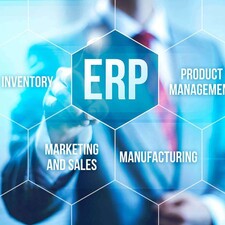Blog
5 Core Benefits of abas ERP: Supporting Digital Transformation and Agility

Summary
An ERP system helps enable connections. Whether you need a ride to the mall or a place to stay in Pittsburgh or a Master’s degree in advanced engineering, online and digital tools can connect you to the resources you need.
Business leaders are profoundly aware of the importance of coordination, internally and externally. Nothing hurts a business’s reputation and revenues more than when customers see a lack of coordination in serving their needs, when redundant and wasteful efforts are common, when “the left hand doesn’t seem to know what the right hand is doing.” Disconnected systems and a lack of coordination between internal departments and business units are the enemy of efficiency, cost control, and employee and customer engagement. The left and right hands need to act together, and everyone sees it when they don’t.
ERP Connects the Dots
An enterprise resource planning system, or ERP system, will connect and coordinate all your business systems and departments, enabling your production people to see what your sales people are doing, and vice versa. So, for instance, when your production people have full, real-time visibility into new customer orders completed by your sales team, does that data help your production people produce just the right amount of product to meet ongoing customer demand? Of course it does.
ERP connects and coordinates all of your business systems and departments, enabling your production people to see what your sales people are doing, and vice versa
The visibility that an ERP system gives you supports your production planning, promotes efficiency in your supply chain and warehouse, keeps your costs down, enables you to deliver on your promises to customers, while keeping your employees in sales and production on the same page, rather than pointing fingers at each other, playing the blame game.
That’s just one small example of how an ERP system, such as abas ERP, helps your business work smarter. Now multiply that example into all the areas of your business, and imagine the positive impacts on your bottom line. Not only does the left hand know what the right hand is doing, but all the fingers work together, as do the legs and everything else. Here are 5 core benefits an ERP system offers your business:
Don't start an ERP selection process without downloading our guide:
How To Buy ERP Software In 7 Easy Steps

#1: Reporting and compliance made simple
When you implement an ERP system, the days of having to go back and manually compile and organize all your relevant data for reporting and compliance purposes are over. No more end-of-the-quarter or month or year migraines around getting your reporting done on time, using up endless hours from countless employees. You can configure your ERP system to automatically generate the reports you want and can then make those reports available to the right people (or all your people – it’s up to you), whether those people are internal or external.
#2: Visibility keeps everyone on the same page
An ERP system makes your relevant data visible in one place so that the relevant people, including shop floor employees, can monitor and measure key performance indicators - KPIs - as they are happening. If a problem arises, the right people will be alerted instantly and can make timely adjustments before the problem becomes an emergency. With an ERP system, you can configure various dashboards so that the right people can gain real-time visibility into the right data that drives their performance. Every member of your team, from the leadership team to the shop floor to the warehouse and your supply chain, is on the right page and has access to all the pages. As coordination goes, ERP systems are the gold standard.
#3: Decision-making improves, becomes data-enabled
Business leaders used to rely on their gut instincts, their intuition, mixed with advice from other people and data that was already old when it was put into some report. Today, and with the support of an ERP system, leaders can still make decisions using their gut instincts, but they can take the advice of former President Ronald Reagan: “trust but verify.”
Leaders can leverage ERP to develop a working hypothesis, even if that hypothesis comes from their gut, that they can then test with all of the data their ERP system provides. So if the data doesn’t support the hypothesis, the leader can adjust it, using data to guide the decision rather than relying upon gut instinct alone. Leaders can also choose to simply follow the data, making decisions informed by what the data says, following historical patterns and the guidance of predictive analytics.
#4: Motivating employees with data dashboards
With an ERP system and the customized KPIs your company generates through it, you can create and display dashboards that let each department or business unit know how it’s doing, not only compared to your targets, but also compared to each other. So even if your warehouse in Peoria is exceeding its target for a KPI, you can compare it to your other warehouse in Paducah. Simply by displaying the relevant, real-time data and KPIs to warehouse employees, you can drive performance and incentivize more competition around productivity.
#5: Predictive analytics to make better, data-driven decisions
So often, making decisions is about recognizing and integrating historical patterns. To use a sports analogy, the coach will be more likely to run a play that has worked consistently in the past, rather than invent a new play on the spot. Business leaders are the same way. They seek to recognize historical patterns and turn them into best practices. But as the game changes, you need new plays, and in today's business world, the game is changing faster than ever. Predictive analytics is the use of data to recognize patterns and make data-informed predictions about the future. More and more, technology can offer us insight not just about what happened before or what’s happening now, but about what will happen next. Again, the human element will always be important, but predictive analytics can help inform human decision making. In the case of some decisions, such as those with low risk, automation, AI and predictive analytics could replace human decision makers.
Bottom Line: Digital Transformation and Agility, Enabled by ERP
What the 5 benefits listed above represent is nothing less than the digital transformation of your business. An ERP system enables you to access and leverage all your relevant data as your operations are moving forward. Knowing what’s happening as it’s happening, and gaining the ability to make course corrections/adjustments along the way, has another popular name: agility. All companies need it, and an ERP system supports it.

Interested in learning more? Contact us today to discuss how abas ERP can help you, or Download the Guide to Maximizing ROI on your ERP Investment


